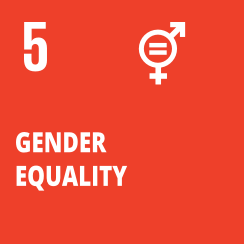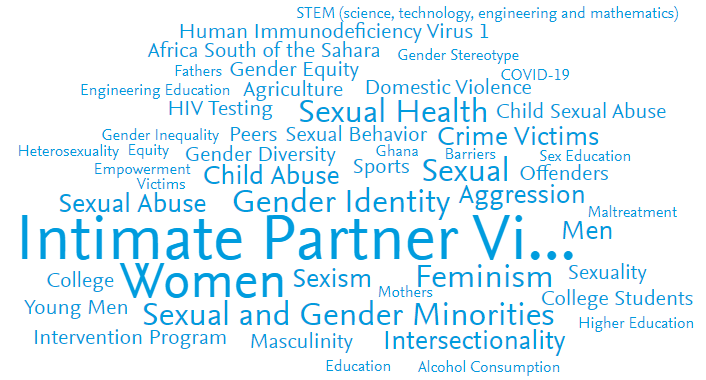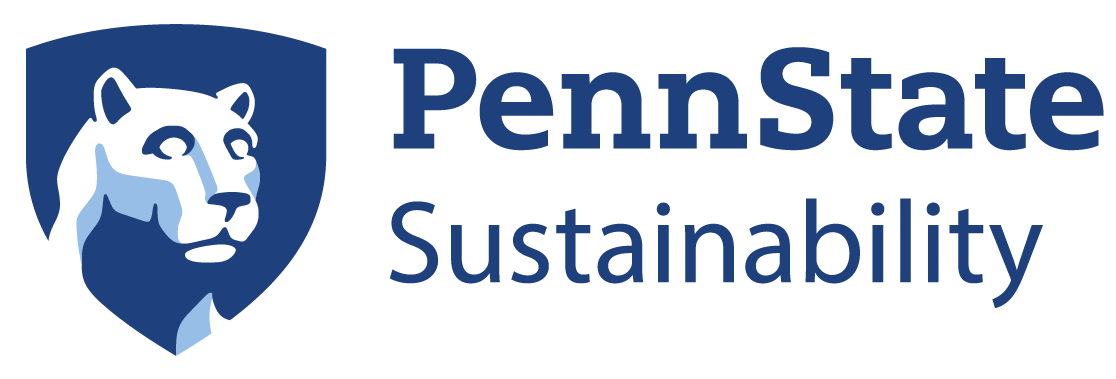
Achieve gender equality and empower all women and girls
Targets for this goal include ending all forms of discrimination, violence, and all harmful practices against all women and girls everywhere; recognizing and valuing unpaid care and domestic work; ensuring women’s full and effective participation and equal opportunities for leadership; universal access to sexual and reproductive health and reproductive rights; equal rights to economic resources; and, adopting and strengthening sound policies and enforceable legislation for the promotion of gender equality.

Source: SciVal.com | This word cloud was created using publications from Penn State researchers
Related News
President Bendapudi shares insight on women leaders in higher ed with CBS News
In a nationally televised broadcast, Penn State President Neeli Bendapudi shared her thoughts about growing opportunities and continuing challenges for women leaders in higher education, and discussed the important role of Penn State and other [...]
Penn State Athletics to celebrate National Girls and Women in Sports Day
Penn State Athletics will celebrate National Girls and Women in Sports Day (NGWSD) throughout the next two weeks surrounding the nationally-recognized day Wednesday, Feb. 7. The department is featuring a variety of events to commemorate [...]
Women farmers quantitatively linked to better community well-being
Having more women in agriculture is associated with greater community well-being, according to researchers at Penn State and the University of Wisconsin-Madison. Their work is the first to quantitatively assess this link, and their findings [...]
Intensifying heat waves threaten South Asia’s struggling farmers – increasingly, it’s women who are at risk
Penn State sociologists study how climate change influences health and well-being, with a particular focus on women and children, including communities like this one in South Asia. Intensifying heat waves threaten South Asia’s struggling farmers – [...]
Penn State community celebrates Campus Pride Month in April
Events continue to be offered to celebrate Campus Pride Month on Penn State's campuses, offered by the Center for Sexual and Gender Diversity, a unit of Penn State Student Affairs, and other units across the [...]
Jaquelin Cochran to speak at April 13 Women in energy and water research seminar
The spring 2023 Celebrating Women in Energy and Water Research seminar series continues on Thursday, April 13, with two seminars by Jaquelin Cochran, director of the Grid Planning and Analysis Center at the National Renewable Energy Laboratory [...]
The Penn State College of Medicine has a Commission for Women program specifically designed to create mentorship for women in the medical field. The Commission for Women also supports initiatives outside the College of Medicine, such as the PAW+ (Physics and Astronomy for Women+) Program, which is an organization dedicated to mentoring women who study Physics and Astronomy.
Penn State has mentoring schemes that support students throughout their academic studies, which include men and women. The Penn State Chaiken Center for Student Success provides peer-to-peer mentoring and connection to resources to help students in the College of Liberal Arts achieve academic and professional success. The Engineering Advising Center at Penn State connects peer-to-peer mentors in the College of Engineering and supports students through academic advising and career development. Several other colleges, such as the College of Education, Business, Liberal Arts, Electric Engineering and Computer Science, and Schreyer also have their own alumni mentoring programs available for students to learn from an alumni mentor.
While Penn State does not track women’s likelihood of graduating compared to men, there are multiple schemes that Penn State has to support women in their studies, especially women in underrepresented fields. For instance, the College of Engineering has the WISE or the Women in Science and Engineering Living Learning Community, specifically aimed towards women in the two named field to find community and achieve at Penn State. Additionally, there is the Women in Engineering Program and the Society of Women Engineers, which are both organization aimed to support the professional and academic success of women in engineering.
While we do not have a policy on this, Policy AD91 is a non-discrimination policy in that extends to admissions.
Penn State encourages applications by women in areas where they are underrepresented by providing multiple resource groups targeted to women studying in fields where they are underrepresented. Penn State has WEP, or the Women in Engineering Program, which provides mentorship, scholarship, and community to undergraduate women studying engineering. Additionally, SWE (the Society of Women Engineers) is a program that offers the same benefits as WEP. Finally, the WISE LLC, or the Women in Science and Engineering Living Learning Community, is a residence hall community that first-year students can apply for to connect with other students in similar fields of study and to gain mentorship and support from upperclassmen and advisors supporting the LLC.
Yes, Penn State’s Discrimination and Harassment and Related Inappropriate Conduct Policy (Policy AD91) specifically states how “It is the policy of the University to maintain an environment free of harassment and free of discrimination against any person because of their actual or perceived age, race, color, ancestry, national origin, sex, sexual orientation, gender, gender identity, physical or mental disability, religion, creed, service in the uniformed services (as defined in state and federal law), veteran status, marital or family status, pregnancy, pregnancy-related conditions, genetic information or political ideas”.
Yes, Penn State’s Discrimination and Harassment and Related Inappropriate Conduct Policy (Policy AD91) specifically states how “It is the policy of the University to maintain an environment free of harassment and free of discrimination against any person because of their actual or perceived age, race, color, ancestry, national origin, sex, sexual orientation, gender, gender identity, physical or mental disability, religion, creed, service in the uniformed services (as defined in state and federal law), veteran status, marital or family status, pregnancy, pregnancy-related conditions, genetic information or political ideas”.
Yes, Policy HRG18 defines the parental leave policy for faculty members of Penn State. Both parents are eligible for 6 weeks of fully-paid leave for a Qualifying Event, which includes “the birth, including birth by surrogacy, of a child or children to the faculty member; the placement of a child or children for adoption with the faculty member; or the appointment of the faculty member as the legal guardian to a child or children”. Policy HR106 defines the parental leave policy for Penn State Staff members, which includes 4 weeks of paid leave after a qualifying event.
Yes, Penn State University Park has 2 child care centers for students, faculty, staff, and members of the community. Eligible Student Parents can receive support when paying for the cost of the child care center.
Yes, Penn State University Park has 2 child care centers for students, faculty, staff, and members of the community. Eligible Student Parents can receive support when paying for the cost of the child care center.
Yes, in accordance to Policy AD91, individuals can report discrimination anonymously using an online form to protect those reporting discrimination. Additionally, it is University Policy to “encourage and enable any member of the University faculty, staff, or student body to make good faith reports of suspected wrongful conduct, and to protect such individuals from retaliation for making such reports to the University or an appropriate authority”.
Yes, Penn State tracks women’s applications, acceptance, and enrollment rates through Penn State Data Digest.
Targets & Indicators
Target 5.1: End all forms of discrimination against all women and girls everywhere
- Indicator 5.1.1: Whether or not legal frameworks are in place to promote, enforce and monitor equality and non-discrimination on the basis of sex
Target 5.2: Eliminate all forms of violence against all women and girls in the public and private spheres, including trafficking and sexual and other types of exploitation
- Indicator 5.2.1: Proportion of ever-partnered women and girls aged 15 years and older subjected to physical, sexual or psychological violence by a current or former intimate partner in the previous 12 months, by form of violence and by age
- Indicator 5.2.2: Proportion of women and girls aged 15 years and older subjected to sexual violence by persons other than an intimate partner in the previous 12 months, by age and place of occurrence
Target 5.3: Eliminate all harmful practices, such as child, early and forced marriage and female genital mutilation
- Indicator 5.3.1: Proportion of women aged 20–24 years who were married or in a union before age 15 and before age 18
- Indicator 5.3.2: Proportion of girls and women aged 15–49 years who have undergone female genital mutilation/cutting, by age
Target 5.4: Recognize and value unpaid care and domestic work through the provision of public services, infrastructure and social protection policies and the promotion of shared responsibility within the household and the family as nationally appropriate
- Indicator 5.4.1: Proportion of time spent on unpaid domestic and care work, by sex, age and location
Target 5.5: Ensure women’s full and effective participation and equal opportunities for leadership at all levels of decision-making in political, economic and public life
- Indicator 5.5.1: Proportion of seats held by women in (a) national parliaments and (b) local governments
- Indicator 5.5.2: Proportion of women in managerial positions
Target 5.6: Ensure universal access to sexual and reproductive health and reproductive rights as agreed in accordance with the Program of Action of the International Conference on Population and Development and the Beijing Platform for Action and the outcome documents of their review conferences
- Indicator 5.6.1: Proportion of women aged 15–49 years who make their own informed decisions regarding sexual relations, contraceptive use and reproductive health care
- Indicator 5.6.2: Number of countries with laws and regulations that guarantee full and equal access to women and men aged 15 years and older to sexual and reproductive health care, information and education
Target 5.a: Undertake reforms to give women equal rights to economic resources, as well as access to ownership and control over land and other forms of property, financial services, inheritance and natural resources, in accordance with national laws
- Indicator 5.a.1: (a) Proportion of total agricultural population with ownership or secure rights over agricultural land, by sex; and (b) share of women among owners or rights-bearers of agricultural land, by type of tenure
- Indicator 5.a.2: Proportion of countries where the legal framework (including customary law) guarantees women’s equal rights to land ownership and/or control
Target 5.b: Enhance the use of enabling technology, in particular information and communications technology, to promote the empowerment of women
- Indicator 5.b.1: Proportion of individuals who own a mobile telephone, by sex
Target 5.c: Adopt and strengthen sound policies and enforceable legislation for the promotion of gender equality and the empowerment of all women and girls at all levels
- Indicator 5.c.1: Proportion of countries with systems to track and make public allocations for gender equality and women’s empowerment







